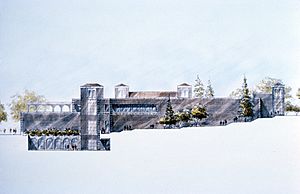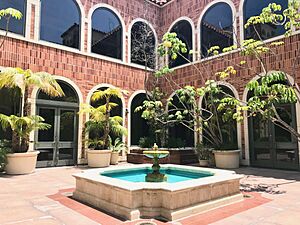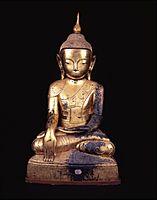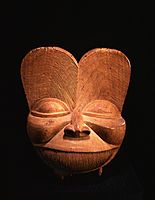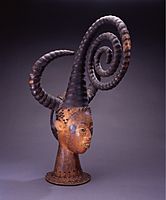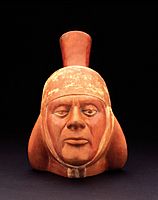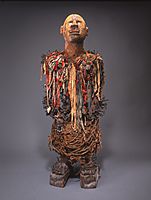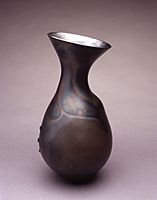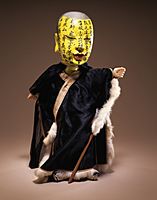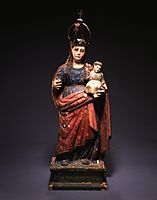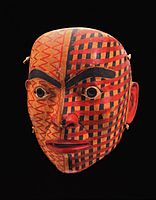Fowler Museum at UCLA facts for kids
 |
|
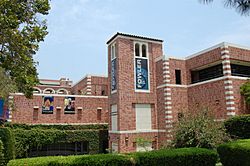 |
|
| Lua error in Module:Location_map at line 420: attempt to index field 'wikibase' (a nil value). | |
| Established | 1963 |
|---|---|
| Location | 308 Charles E. Young Drive Los Angeles, CA 90024 United States |
| Type | Art museum, University of California, Los Angeles (UCLA) |
The Fowler Museum at UCLA, often called The Fowler, is a special museum located at the University of California, Los Angeles (UCLA). It shows art and cultural items mainly from Africa, Asia and the Pacific Islands, and the Americas. The museum explores both old and new cultures.
The Fowler Museum usually has several art shows happening at the same time. It also hosts talks about different cultures, music shows, art workshops, family events, and festivals. You can find The Fowler on the northern part of UCLA's campus, next to Royce Hall. The UCLA School of the Arts and Architecture helps run the museum.
Contents
The Fowler Museum's Story
The museum started in 1963. It was first called the Museum and Laboratories of Ethnic Arts and Technology. Its first home was in the basement of Haines Hall at UCLA. The main goal was to bring together all the different collections of non-Western art and items on campus.
Besides collecting, the museum also started research projects and exhibitions. In 1971, its name changed to the Museum of Cultural History. By 1975, its collections were among the best in the country for university museums. It still holds that high rank today.
In 1981, UCLA Chancellor Charles E. Young and museum director Christopher B. Donnan planned a new building. This new building would help show the collection better. The large building opened on September 30, 1992. It was named the Fowler Museum of Cultural History. This name honored the Fowler Foundation and the family of Francis E. Fowler Jr., who gave a lot of support.
In 1996, Doran H. Ross became the museum's director. Then, in 2006, the museum's name officially changed to the Fowler Museum at UCLA.
In 2024, the museum returned several important items to Ghana. These items were taken by British forces from the Ashanti Empire in the 1800s. The returned items included an elephant tail whisk, a special chair, gold ornaments, and jewelry. In the same year, the museum also returned 20 objects to the Waramungu community in Australia.
Amazing Collections at The Fowler
The Fowler Museum has over 120,000 art and cultural items. It also has 600,000 archaeological objects. These items come from ancient, traditional, and modern cultures. They represent Africa, Native and Latin America, and Asia and the Pacific.
Most of the Fowler's items were given as gifts by people. A very large gift came from Sir Henry Wellcome in 1965. This gift included 30,000 objects. It forms the main part of the museum's African and Pacific collections.
The museum also has more than 15,000 textiles. These are fabrics that show the history of cloth over 2,000 years. They come from five different continents.
The Fowler Family Silver Collection has 400 silver items. These pieces are from Europe and the United States, made between the 1500s and 1800s. Some famous artists like Paul de Lamerie, Karl Fabergé, and Paul Revere made these items.
In 1969, Hollywood actress Natalie Wood gave the museum a collection of ancient Mexican ceramics. In 2013, the museum received many gifts for its 50th anniversary. One big gift was from collector Jay Last and his wife, Deborah. It included 92 wood and ivory objects from the Lega people of the Democratic Republic of Congo.
Many of the museum's items were collected directly from their original places. This helps the museum understand their stories. The museum is also collecting more items from Latin America. This is because Los Angeles has a growing Latin American population. In 1997, the Daniel Family donated over 900 Mexican works. These include "Trees of Life" ceramics, "Day of the Dead" figurines, and masks.
Exciting Exhibitions
The Fowler Museum hosts many different exhibitions. These shows help visitors learn about various cultures and art forms.
Some past exhibitions include:
- Intersections: World Arts, Local Lives
- Reflecting Culture: The Francis E. Fowler, Jr. Collection of Silver
- Continental Rifts: Contemporary Time-based Works of Africa (2009)
- Plus several other changing exhibitions
Special Collection Highlights
-
Chief's Mask, Haida people, British Columbia, 19th century
-
Portrait vessel, Moche style, north coast Peru, 100–800 C.E.
-
Mask (amiilk), Tsimshian peoples, British Columbia, Canada, 19th century
Museum Directors
Here are the people who have led the Fowler Museum:
- Christopher B. Donnan (1981–1996)
- Doran H. Ross (1996–2001)
- Marla C. Berns (2001–2021)
- Silvia Forni (2022-present)
In 2007, Shirley and Ralph Shapiro, who are philanthropists from Los Angeles, gave a large donation. This donation helped support Marla C. Berns's position as director. They recognized her important work for UCLA and the community. In 2013, Berns received a special award from France. It was called the Chevalier of the Order of Arts and Letters. This ceremony happened in Paris at the Quai Branly Museum. It was during the opening of an exhibition called Secrets d'ivoire. This exhibition showed African artwork from the Lega people of the Democratic Republic of the Congo. This artwork was given to the Fowler by collectors Jay T. and Deborah R. Last.


